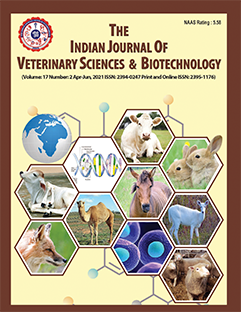Effect of Oxidative Stress on Estrus Synchronization and Pregnancy Rate after In-Vitro Produced Embryo Transfer in HF Crossbred Cattle
DOI:
https://doi.org/10.48165/ijvsbt.21.5.05Keywords:
Cow, Conception rate, IVP Embryo transfer, Heifer, Oxidative stress (MDA)Abstract
The present research involved 60 normal cycling recipients, including 30 heifers and 30 cows, synchronized using a double PGF2α protocol. A total of 140 oocytes were collected from 11 elite donors, averaging 12.72 oocytes per ovum pick-up (OPU) session at the Government Bovine Breeding Farm in Tathwade. Total 46 blastocyst-stage developed embryos were transferred to various farms in Western Maharashtra. Estrus response and ovarian corpora lutea (CL) development was higher in synchronized heifers (86.66%) than in cows (83.33%). Pregnant heifers had larger CL diameters and luteal areas than non-pregnant ones, while CL diameters in cows were similar regardless of pregnancy status. Total 24 (80.00%) heifers and 22 (73.33%) cows were suitable for embryo transfer. Overall, 76.66% of recipients received in-vitro-produced embryos, with conception rates of 50.00% in heifers and 31.82% in cows, resulting in an overall rate of 41.30%. Malondialdehyde (MDA) levels were higher in non-pregnant recipients compared to pregnant ones, suggesting that elevated MDA levels may be a useful selection criterion in embryo transfer technology.
Downloads
References
Ahlawat, A. R., Dongre, V. B., Ghodasara, S. N., Murthy, K. S., & Gajbhiye, P. U. (2015). Single and double dose of PGF2α for estrus induction and conception rate in Gir cows. Intas Polivet, 16(1), 54–56.
Bernabucci, U., Ronchi, B., Lacetera, N., & Nardone, A. (2005). Influence of body condition score on relationships between metabolic status and oxidative stress in periparturient dairy cows. Journal of Dairy Science, 88(6), 2017–2026.
Deshmukh, S. G., Pawshe, C. H., Sahatpure, S. K., & Bankar, P. S. (2013). Synchronization of estrus with double dose of PGF2α in cows. Indian Journal of Veterinary Sciences and Biotechnology, 9(2), 59–61.
Ferraz, P. A., Burnley, C., Karanja, J., Viera-Neto, A., Santos, J. E. P., Chebel, R. C., & Galvão, K. N. (2016). Factors affecting the success of a large embryo transfer program in Holstein cattle in a commercial herd in the Southeast Region of the United States. Theriogenology, 86(7), 1834–1841.
Fukaya, S., Yamazaki, T., Abe, H., Nakagawa, S., Baba, T., Bai, H., & Kawahara, M. (2024). Characterization of conception rate after embryo transfer in comparison with that after artificial insemination in dairy cattle. Journal of Dairy Science, 107(11), 9516–9526.
Galma, B. (2020). Estrus response of Boran and Boran-Holstein crossed cattle to PGF2α and pregnancy rates to sexed and conventional semen (Master’s thesis). Addis Ababa University, Holeta, Ethiopia.
Gugssa, T., Ashebir, G., & Yyneshet, T. (2016). Effects of fixed-time AI and AI at detected estrus on conception rate in smallholder zebu and crossbred heifers and cows subjected to double PGF2α administration. Tropical Animal Health and Production, 48, 1209–1213.
Isobe, T., Kajihara, Y., & Ikebata, Y. (2024). Influences of oxidative stress and energy balance on pregnancy rates after the transfer of embryos to repeat-breeder Japanese Black cattle. Animal Science Journal, 95(1), e13947.
Jaskowski, B. M., Bostedt, H., Gehrke, M., & Jaśkowski, J. M. (2021). Ultrasound characteristics of the cavity corpus luteum after oestrus synchronization in heifers in relation to the results of embryo transfer. Animals, 11(6), 1706.
Krishana, N. V., Reddy, Y. N., Tagore, K. V. V., & Veera, K. (2022). Fertility response in postpartum anoestrous cows using Ovsynch and double PG protocols. The Pharma Innovation Journal, 11(12), 2809–2813.
Malik, A., Heppy, D. M., & Widaningsih, N. (2018). Comparing response of estrus synchronisation in the heifers and cows on estrus initial, duration of estrus and pregnancy rate Bali cattle. Advances in Animal and Veterinary Sciences, 6(6), 242–245.
Pérez-Mora, A., Segura-Correa, J. C., & Peralta-Torres, J. A. (2020). Factors associated with pregnancy rate in fixed-time embryo transfer in cattle under humid-tropical conditions of México. Animal Reproduction, 17(2), e20200007.
Ridgman, W. J. (1990). Statistical methods (8th ed.). Iowa State University Press.
Sahatpure, S. K., & Patil, M. S. (2008). Synchronization of oestrus with prostaglandin F2 alpha analogue in non-descript cow. Veterinary World, 1(7), 203–204.
Sangsritavong, S., Combs, D. K., Sartori, R., Armentano, L. E., & Wiltbank, M. C. (2002). High feed intake increases liver blood flow and metabolism of progesterone and estradiol-17β in dairy cattle. Journal of Dairy Science, 85(11), 2831–2842.
Say, E., Özmen, M. F., & Sağırkaya, H. (2021). The influence of corpus luteum size on the conception in embryo transfer recipient cows. Livestock Studies, 61(2), 77–81.
Sheldon, I. M., & Dobson, H. (2004). Postpartum uterine health in cattle. Animal Reproduction Science, 82–83, 295–306.
Spears, J. W., & Weiss, W. P. (2008). Role of antioxidants and trace elements in health and immunity of transition dairy cows. The Veterinary Journal, 176(1), 70–76.
Thomson, S. P., Holmes, R. J., Landes, P. T., & Allworth, M. B. (2021). Assessment and selection of the recipient cows’ corpus luteum at the time of embryo transfer, and its influence on conception rate. Australian Veterinary Journal, 99(7), 288–292.
Yazlık, M. O., Kurt, S., Terzi, O. S., Kaya, U., & Olgac, K. T. (2022). Comparison of blood metabolites and GSH-Px, SOD, MDA levels as a predictor of pregnancy in primiparous cows after the presynch-ovsynch protocol. Large Animal Review, 28(5), 227–233.
Downloads
Published
Issue
Section
License
Copyright (c) 2025 Indian Journal of Veterinary Sciences and Biotechnology

This work is licensed under a Creative Commons Attribution-NonCommercial-NoDerivatives 4.0 International License.




